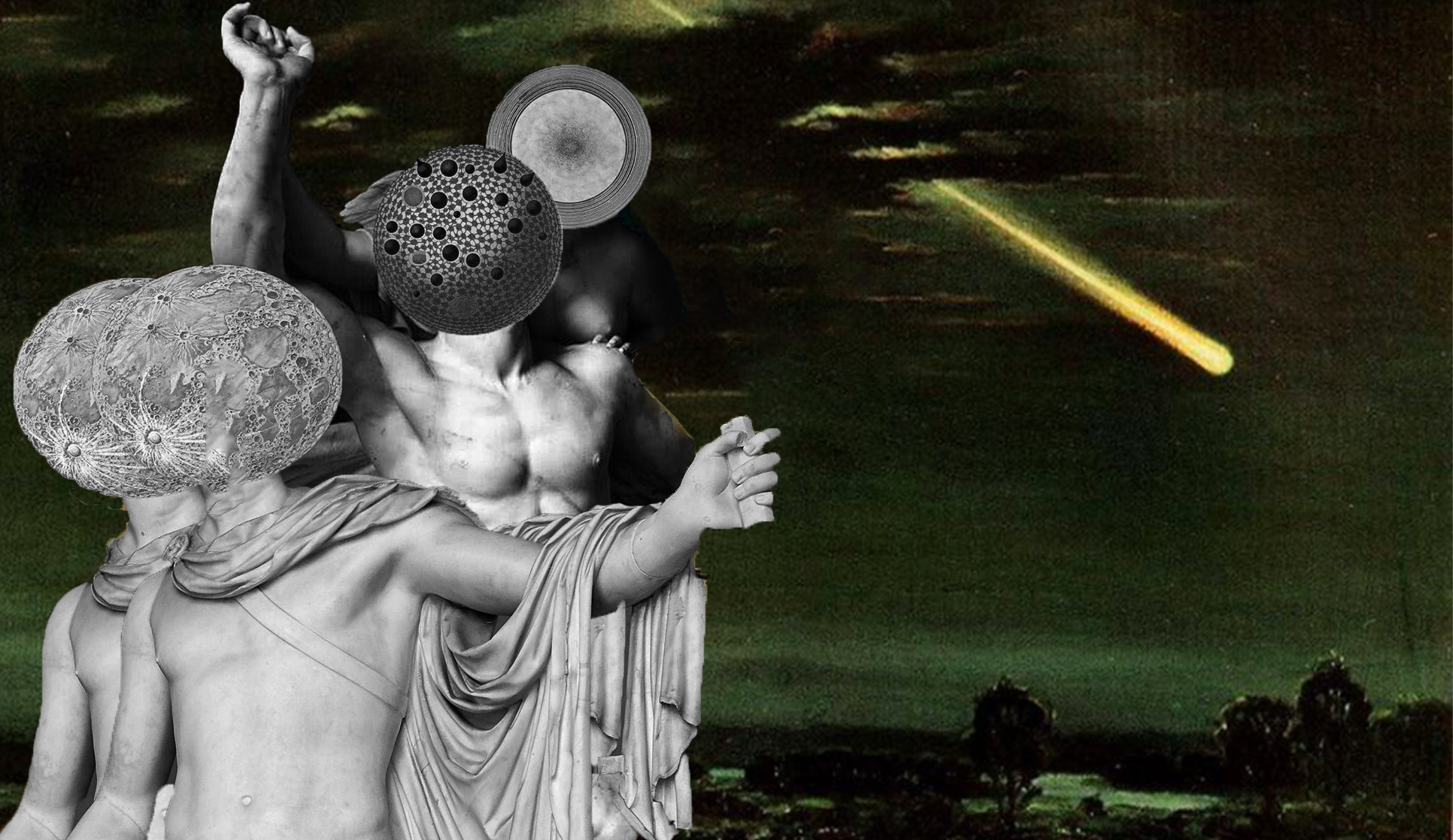Here for PART I
Here for PART II
Anerkennung. A German word of common use; it means recognition. Hegel makes use of it, and makes it an important moment of the process of individuation. Individual subjectivity is formed only in the relationship with the Other. To recognize myself I must recognize the one who looks at me. Anerkennung speaks of an individuation that is socialization – that starts from relation in order to instantiate itself. In the Phenomenology of Spirit, Hegel demonstrates this instantiation of the ego on the basis of the relation with the Other in three steps, the last of which is the affirmation of the coexistence of the ego and the Other. He proceeds thus in the following way, on a single page:
(a) an individuality faces the world and experiences otherness, but it cannot keep it independent from herself, except by erasing it or losing herself in it. It is the principle of predation in the first experience of the world: to eat or be eaten.
b) the attempt to deny otherness as such and the dependence on it clashes with the paradox related to the fact that otherness is now part of the horizon of the ego: denying otherness means denying the ego. In the paradoxical attempt to deny otherness,
c) the ego actually returns to itself, freeing herself from dependence on the other only through the free letting-be of otherness. Entläßt also das Andere wieder frei, makes the other free again, writes Hegel.
The first figures of the Phenomenology are not historical figures, which means that they are not limited in a specific time horizon. The “first experience of the world” and the Anerkennung are paths that every individuality must walk. Yet, in the a-historicity of this eternal recognition a historical difference imposes itself. Such is the difference between the imitating hominids and Nimrod, the great hunter. Freud called the mechanism of eroticization of the mother as the first female figure by the child “Oedipus complex”, but it was an arbitrary choice dictated by familiarity with Greek culture. Nimrod also married the mother. He was a powerful king, founder of Nineveh, and sources point to him as the one who had the idea to defy God by building the tower at Babel. What relationship exists between those who chipped obsidian to use it as hyenas use their teeth on carcasses, and a King-hunter? Calasso writes: to survive, in hunting as in scavenging, one must imitate. The hunter must move like a predator, must think like a predator, must have fangs like the predator because, with the predator, he shares one thing: the prey. It doesn’t matter if there are fangs, arrows, stones or bullets, whether one is dealing with a living body or a dead one. It is the prey, the thing that never changes. But what is the prey? Food, energy, sustenance. And what is food? What our ancestors were to other predators, and what we can always go back to being. The Other is such only if we justify it from what is ultimately not us and not him: something defined.
Hegel’s Anerkennung works as long as one thinks of recognition as a knowing-that-stops, first the otherness, then the ego, and then the two of them together. But in the first opening, no one recognizes anyone, and the individuality that faces the other is not an individuality: one stops, careful, and throws oneself into the abyss one wants to fill. The horror of recognition comes to an end when attention vanishes – and the Other disappears, flees, without uttering a hiss.
The prey, that is, the sacrificial victim. Why say sacrificial victim? What is the prey “sacrificed” for? For the sustenance of the predator, it has been said. Animals have long been favourite subjects of mythology and ritual. At the same time, they have also been the subjects of mythology and rituals. It was the animal that was sacrificed to the god, yet any killing outside the sacred was an unclean sacrilege, an attack on cosmos. And hunting was sacred, because it was the sacrifice of the animal that allowed to feed. The animal, the animals, have been sacred for a long time. People have imitated them for a long time, and they have done so out of fear, or out of hunger.
Behind the mechanism of mimetic desire, of the object desired insofar as it is possessed by the imitated, perceived as an object that produces an advantage, there is a more rudimentary and less secret mechanism. Or, more secret precisely because it is more rudimentary. It is the libidinal mechanism, the engine from which it makes sense to define mimetic desire.
Girard states that the subject-object relationship is triangular: subject, (desired) object, possessor of the object. Girard speaks of metaphysical desire, a search for fullness, a yearning for being through the instances offered by otherness. A Hegel whose recognition is an antagonistic and continuous dependence on otherness. What I do not possess, the other does, and to desire it is to desire the negation of the other. But the mimicry of predation, the sacredness of the prey, the race to the carcass – this is not the step of one who feels a metaphysical void to be filled. It is the instantiation of a relationship (of imitation) on the basis of a common agreement, of a shared object, which is not the object possessed by the one being imitated: it is the intensity that drives both, imitator and imitated, to meet over the carcass already torn apart by predators, that drives both to tear it apart even more. The hominid and the hyena do not cross their gaze in the flowering of recognition: indeed, they never cross it. The only entanglement that occurs dances around the intensity called hunger, where the hominid studies the hyena’s teeth, while the hyena tears the meat from the carcass. In a radical and intangible otherness, a dark and dull abyss, faint lights shine: libidinal energy, attention, and technique. Sharing in the unfathomable: contemplation.
There is a famous passage in Lyotard’s Libidinal Economy, famous for its overbearingly polemical tone but, equally, for its fundamental content for understanding the text itself. The passage goes like this:
The English unemployed did not make themselves laborers in order to survive, they have – hold on to your hats and spit on me – enjoyed the hysterical, masochistic, I don’t know what, exhaustion of enduring in the mines, in the foundries, in the workshops, in hell, they have enjoyed in and of the insane destruction of their organic bodies that certainly had been imposed on them, they enjoyed that it was imposed on them, they enjoyed the decomposition of their personal identity, of that which their peasant tradition had built for them, enjoyed the dissolution of families and villages, and enjoyed evening and morning the new monstrous anonymity of the suburbs and pubs. (Lyotard, 2015, p.126)
It is Fisher who chooses the most apt phrases to comment on these words, and those on Baudrillard and the dream of symbolic exchange that precede them. It is through raising the question of the scandalous core of this passage, of that invitation to spit on him that Lyotard engraves in the middle of the period, that Fisher weaves the right questions. “Raise your hand if you would like to abandon the anonymity of the suburbs and pubs and return to the organic slush of the fields,” because yes, it revolves around that question the relationship to capitalism: pain and delight. “Let’s raise our hands, therefore, all those who would concretely like to return to the territorialities, to the family, to the pre-capitalist villages”, because yes, even behind that lost referent lurked monsters. “Raise your hands, again, those who really think that these desires to restore the ‘organic totality’ [of pre-capitalism] are alien to the culture of late capitalism, rather than totally embedded components in the libidinal infrastructure of capital.”
So there you have it: there are no primitive societies, the Moires were already pulling the thread of what was to come, with no possibility of appeal, and looking back only means taking the same path again. For Fisher, it is a question of arguing around the legitimacy of accelerationism. For Lyotard, it’s about suspending the suspension generated by the theory; Marx’s fury at capitalism is already an internal element of the theory of commodity fetishism, etc., but it escapes it. The libidinal is the Other. But the Other in the penumbra, the “other man” who, Plotinus says, stalked us, of whom we know neither who he was nor where he came from. The Other in the self; the repeated difference; the repetition of the affirmation of difference. The one who does not imitate, but who watches the dance of imitation. The one who does not recognize himself, but who watches the game of recognition. The one who is not himself, and is not the other, because he has no time to be either. The gaze that looks at the gaze that looks. And it always does so with the attention that belongs to the most radical exoticism.
Capitalism rests on the structures of production of libidinal energy. Baudrillard’s analysis of the political economy of the sign offers a clear example of this. Consumption, the attractive power of the object of consumption, resides in its sign function, which generates the value attached to it. What is sign-value? The social value that the object holds, the status that is acquired the moment the object is purchased. The value of use disappears, or is hidden, and the rules of supply and demand are no longer instantiated on the real referents of value, but on something imaginary. Baudrillard writes about the 80s and 90s. Today, through social network marketing and the increasingly manifest marketplace of signs, Baudrillard’s fundamentally libidinal theory is increasingly crystallized – especially around the concept of hyperreality and simulation. Why libidinal theory? And why theory? Here too, as with Marx, the lividity that leaks from every page of the French sociologist’s analyses is an inescapable component of his own theory. And it overturns it, violates it. The theory makes us say “what acumen! what intelligence! what reason!”, but the libidinal, the intensity of that hatred that runs through the skin and veins and hair of Baudrillard as of Marx is the radical otherness that pushes us to immerse ourselves in the theory. It was hunger, then it is anger. Paraphrasing the latter, conveyed through Baudrillard’s mouth: the revenge of the aborigines whose limbs have been torn off and heads hung on pikes and women raped and burned and children enslaved lies in the fact that the “circumscribing of the world in a sphere”, the territorialization of capitalism as well as imperialism, the unifying West and the enlightenment of reason have accomplished nothing.
Along the irreversible path of universal progress, nothing “wild” is dead, everything rises or will rise again with vehemence and virulence, “right in the heart of our ultra-sophisticated and ultra-vulnerable systems, disarming them” without gasping. “This is the fate of radical otherness, and it cannot be resolved in either a homily of reconciliation or an apology of difference” (Baudrillard, 2013, p.150). There is a substantial obsolescence that pervades the capitalist system and in the systems of reference attached to it, a pungent stench of cancerous fabric. It is not possible to limit deterritorialization because it is the function and effect of a radical otherness, of libidinal energy, and the bearer of its own need: pure exoticism.
Girard’s triangular-structured desire, in an entirely paradoxical way if one takes into account the psychoanalytic character of the analysis he proposes at this juncture, is as theoretical as it gets. Grappling with libidinal energy, Girard suspends everything and explains. What? Something that escapes him as soon as he has it in his hands. He carefully embroiders, thread by thread, like Penelope. Imitator, model, desired object. Simple, direct, metaphysical. But what metaphysics is there in a desire? What voice does a desire have, if we link it back to ontology, to the rhetoric of fullness, to Bonaventure’s enlightenment? What Being does the hungry hominid desire from the Hyena, and from the carcass it bites? Does it desire its fangs? That (instrumental) fullness useful to fill another void that is a physiological void, of the intestines? Does it desire its place, to fill that space on which to rest its knees to bend over the carcass and tear off flaps of flesh? What model is the hyena? Is it the hyena in its animality, in its eternally intangible being, or the hyena as kata agalmata, beautiful image? No, no, it’s more “wild.”
There is no metaphysics in the tension that leads to the opening of the scenario of the encounter between scavenger animal and future scavenger imitator. The metaphysics comes later. There, at that moment, radical otherness is manifested because a commonality, a lofty commonality, a libidinal commonality is manifested: the need for food. It is there the Anerkennung, there the world: in the commonality of intent, the sharing of interests – afterwards, the technique in its forms. Here is Segalen’s unrestrained song: in radical exoticism the common is rediscovered.
References
- Baudrillard, The Transparency of Evil, tr. J. Benedict, Verso, London, 2013
- Baudrillard, Simbolic Exchange and Death, tr. I. H. Grant, Sage Pubns Ltd, 1993
- Calasso, The Celestial Hunter, tr. R. Dixon, Farrar Straus & Giroux, 2020
- Deleuze, Guattari, A Thousand Plateaus, tr. B. Massumi, Minnesota UP, 1987
- Deleuze, Guattari, Anti-Oedipus, tr. M. Seem, Penguin Classics, 2009
- R. Girard, The One by Whom Scandal Comes, Michigan State UP, 2014
- R. Girard, La Violence et le Sacré, Grasset, 2014
- Hegel, The Phenomenology of Spirit, tr. T. Pinkard, Cambridge UP, 2019
- Lyotard, Libidinal Economy, Bloomsbury, 2015
- Plotinus, Enneads, tr. S. McKenna, Larson Pubn, 1992
- V. Segalen, Essay on Exoticism: An Aesthetics of Diversity, tr. Y. R. Schlick, Duke University Press, 2002







